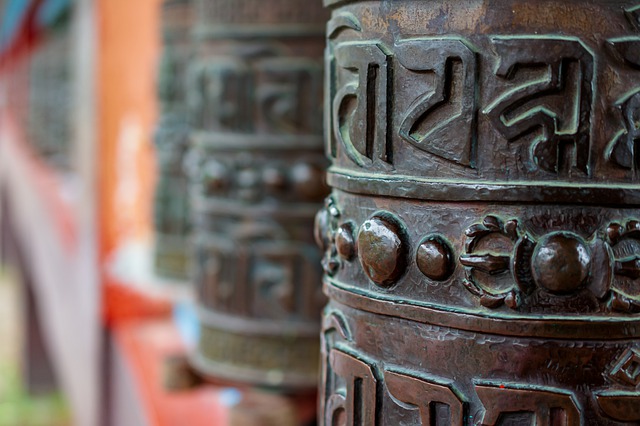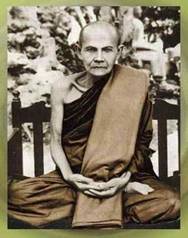I heard that the Blessed One was once in Nadika in the brick hall. There he addressed the monks: – “Monks, mindfulness of death – when it is developed and persecuted – is of great impact and benefit. It has immortality as its ultimate end. And how is mindfulness of death so developed and pursued that it is so?”
‘There is the case where, when the day has passed and the night returns, a monk ponders, ‘Many are the [possible] causes of my death. A snake could bite me, a scorpion could sting me, a centipede could bite me. So my death would occur. That would be an obstacle for me. I could trip and fall, my digested food could unbalance the body, my bile could be provoked, my phlegm could be provoked, and the winds in the body could be provoked. That is how my death would come about. That would be an obstacle for me.’
‘Then the monk should inquire: “Are there any unwholesome qualities that I have not given up that would hinder me if I died in the night?” If, while pondering, he realizes that there are unwholesome, awkward qualities that he has not given up and that would hinder him if he died in the night, then he should add additional desire, effort, diligence, effort, undivided mindfulness, and vigilance for giving up these unwholesome, clumsy traits. Just like when a person whose head is on fire provokes additional desires, exertions, diligence, undivided mindfulness and vigilance in order to put out the fire on their head, the monk should take additional measures to desire, exertion, diligence, effort, undivided mindfulness and vigilance for the abandonment of the same unwholesome, clumsy qualities. But if, as he ponders, he realizes that there are no unwholesome, clumsy qualities that he has not given up and that would hinder him if he died in the night, then for that reason he should dwell in joy and rapture and trains himself day and night in healing qualities.’
‘There is also the case where, when night goes by and day returns, a monk thinks, ‘Many are the [possible] causes of my death. A snake could bite me, a scorpion could sting me, a centipede could sting me. So my death would occur. That would be an obstacle for me. I could stumble, I could fall, my digested food could bring my body out of balance, my bile could be provoked, my phlegm could be provoked and wind forces penetrating the body could be provoked. So my death would come about. That would be an obstacle for me.’
‘Then the monk should inquire: “Are there any unwholesome, clumsy mental qualities that I have not given up that would hinder me if I died during the day?” If, while pondering, he realizes that there are unwholesome, awkward qualities that he has not given up and that would hinder him if he died in the night, then he should add additional desire, effort, diligence, effort, undivided mindfulness, and vigilance for giving up these unwholesome, clumsy traits. Just like when a person whose head is on fire provokes additional desires, exertions, diligence, undivided mindfulness and vigilance in order to put out the fire on their head, the monk should take additional measures to desire, exertion, diligence, effort, undivided mindfulness and vigilance for the abandonment of the same unwholesome, clumsy qualities. But if, as he ponders, he realizes that there are no unwholesome, clumsy spiritual qualities that he has not given up and that would hinder him if he died in the night, then for that reason he should dwell in joy and rapture and train himself day and night in wholesome qualities. “So, monks, mindfulness of death is developed and pursued so that it is of great fruit and benefit, takes a foothold in immortality, and has immortality as its ultimate end.’
Reflection by MC Brigitte:
The Buddha talked about the contemplation of death, ‘Maranasati’. Sati is mindfulness, bringing your mindfulness to the subject of death. Death will happen for all of us. He said of all the animals in this world, the biggest footprint is the footprint of an elephant, which covers all the other footprints. So, of all the meditations, the biggest or most important meditation is maranasati. Being aware and contemplating the possibility of death – is the most important meditation exercise.
He once asked one of his main disciples, Ananda, his personal assistant. Ananda was with the Buddha for 25 years and memorized his teachings. It was very important for the teachings we have today. The Buddha asked Ananda, “How often do you think about death?”
Ananda said, “About seven times a day.” The Buddha told Ananda he was very negligent. The Buddha himself thinks of death at every in-breath. He contemplates, if he breathes in and does not breathe out anymore, then he would die. Similarly, he contemplates – if he breathes out and cannot breathe in anymore, then he would die.
So, the Buddha thought of death with every breath he took.
There are many ways we can contemplate it in daily life. We can see the things we have inherited from relatives or loved ones that have passed away. We can contemplate that these things belonged to that loved one who has died and is not here anymore. We see their pictures and know that this person has died. So many beings and people have died before us and are not here anymore. Or you could visit a graveyard and read the names on the gravestones. These were real people who had dreams and had wishes. But now, they are dead, they are not here anymore. Nothing else they can do to fulfill what they wanted to do. There were billionaires, very wealthy and rich but they also died. They can’t use their wealth anymore.
All people die, there is no difference.
Mindfulness of death helps us to set our priorities in life. Such as contemplating what is really important in my life? Are the little things that I am bothered about – such as wishes, wants, desires or having this or that, having beautiful things – they are impermanent, are they really important? What do these things do for me if I will die? Then we will think about things that are useful, wholesome now in this life and in future lives – if you believe in future lives. It will change the way we set priorities.
Bringing mindfulness of death to our minds helps us to maintain the teachings taught by the Buddha. The first is to do the wholesome and to nourish wholesome things that have already arisen in our minds and life. Secondly, try to avoid unwholesome things from arising. If they have already arisen, do what you can to reduce them and to let them go. The third is to stand above both – purify the mind. Let go of both wholesome and unwholesome. Practising vipassana to learn to stand above both good and bad.
We also have to contemplate the Buddha himself. It was one of the things that brought him to leave the life of a prince behind. Siddhartha was a prince, he had everything he could ever think and wish for. But when he left the palace with his attendant, he saw the four signs. The first was a man who was sick, the second was an old man and the third was a corpse. The fourth was an ascetic – someone who tried to practise to overcome samsara. This was why the Buddha left the palace because he saw the urgency of practising to reach the end of samsara.
What else can we do to practise the mindfulness of death in daily life? Be present and mindful. Bring joy into your life, bring light into your body and mind. Think positive. Especially now in this time when we have the pandemic, which also includes sickness and death. That we keep a wholesome mind, shine our light on others by being positive.
There are also meditations that can help us such as the meditations I give daily. Such as contemplation on the five outer objects of the body. Hair on the head, body hair, nails on your fingers and toes, teeth in your mouth, and skin. These five outer objects we can see on our body. We contemplate them and their impermanence. They grow old and change. There is death and we can see that.
The Buddha taught more than these. He taught the 32 parts of the body. The first 5 I had mentioned. There are also bones, organs, and fluids within the body. Doing this contemplation mainly helps us see impermanence. They are not under our control, seeing these three characteristics of our existence – impermanence (anicca), the uncontrollable nature (anatta), and the suffering – non-satisfying nature (dukkha) – helps us become clear about the certainty of our death one day.
There are ways in our lives where we can see these things much easier. Especially for those of you who work as a doctor, in the hospice or in pathology, or even in a retirement centre. You are close to death all the time. You can see people dying. You can use this understanding, not just see it outside but bring this knowledge inside yourself, contemplate that this will be you one day. Especially in the West, death is something we hide. We don’t see dead people, they are immediately covered and taken away where we can’t see them. Even old people, we put them in retirement homes so we don’t see them, the sick are places in hospitals. Death is something we avoid seeing. This is completely insane because it actually brings us face-to-face with these great truths, seeing things as they really are. Death is a very important part of life, as important as birth is.
If you have the possibility to see death for yourself, use that knowledge. Bring it into your mind and make yourself aware that you will also die. Others die, so will you and so will those you love or hate. There is no way for anyone to escape. All the arahants, the bodhisattvas, and even the Buddha died. There is an end to their lives. Make this clear to yourselves.
This is not to make you fearful or negative. It helps you set priorities and to be more wholesome in everything you do and think. It helps to make you more attentive and not just letting time slip away, wasting time on things that don’t matter. Use this precious time as a human being wisely.
One thing the Buddha also said, it is very rare to be born a human being. It is much more likely to be born as something else. There are 31 realms of existence and the human realm is the one in the middle. As a human, it is much easier to practice meditation because we see both suffering and happiness. Whereas lower realms like the animal or hungry ghosts or hell-beings have a lot of ignorance and suffering. If you have a lot of suffering you are not able to gain this teaching or meditate because the only thing you can think about is to get out of suffering.
Unfortunately, this is also the case for the higher realms. The fine material beings whom most of us cannot see – we call angels or devas in Sanskrit, are also unlikely to meditate because they always experience happiness and fun. Their existence is full of joy and fun. If they always have fun, it is difficult to tell them to sit down and meditate because they don’t experience suffering. Even the highest realms in samsara – the Brahmas, don’t have fun, but they have a very high level of bliss and happiness of standing above everything. It is hard to get to them and give them this teaching of getting out of samsara. Our existence as humans is the most suitable one to reach enlightenment and get out of samsara. Again, it shows how important this existence you have is. Now that you are still healthy and alive and able to practice, do this mindfulness of death contemplation without getting negative. It will give you more freedom.



